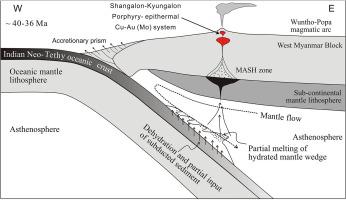当前位置:
X-MOL 学术
›
Ore Geol. Rev.
›
论文详情
Our official English website, www.x-mol.net, welcomes your
feedback! (Note: you will need to create a separate account there.)
Eocene arc magmatism and related Cu-Au (Mo) mineralization in the Shangalon-Kyungalon district, Wuntho-Popa Arc, northern Myanmar
Ore Geology Reviews ( IF 3.2 ) Pub Date : 2020-10-01 , DOI: 10.1016/j.oregeorev.2020.103678 Thiri Ye Htut , Kezhang Qin , Guangming Li , Kyaing Sein , Noreen J. Evans
Ore Geology Reviews ( IF 3.2 ) Pub Date : 2020-10-01 , DOI: 10.1016/j.oregeorev.2020.103678 Thiri Ye Htut , Kezhang Qin , Guangming Li , Kyaing Sein , Noreen J. Evans

|
Abstract The Shangalon-Kyungalon Cu-Au (Mo) ore district is located on the south-eastern margin of the Kanzachaung batholith in the Wuntho-Popa Arc, Myanmar. Porphyry and epithermal Cu-Au mineralization are associated with the Late-Eocene magmatic rocks. In this study, zircon U-Pb dating of gabbroic diorite, diorite porphyry, tonalite porphyry, and granodiorite yielded ages of 38.0 ± 0.35 Ma, 37.8 ± 0.35 Ma, 37.4 ± 0.27 Ma, and 36.9 ± 0.26 Ma, respectively. These rocks show sub-alkaline characteristics, LREE-enriched patterns with weakly positive/negative Eu anomalies, enrichment of LILEs and depletion of HFSEs. They have obviously higher initial Sr ratios and lower eNd(t) and eHf(t) values (Isr = 0.7066; eNd(t) = −0.5 to −4.8; eHf(t) = 0.7–9.7) than the mid-Cretaceous Kanzachaung batholith (Isr = 0.7046; eNd(t) = 2.4–4.5; eHf(t) = 10.9–15.1), indicating crustal materials were most likely added to the arc magma source. In particular, the gabbroic diorite has higher initial Sr, more enriched Nd-Hf isotopic compositions (Isr = 0.7081, eNd(t) = −4.6 to −4.8, eHf(t) = 0.7–2.3) and lower SiO2 content relative to the other magmatic rocks studied (Isr = 0.7068–0.7059; eNd(t) = −0.5 to −2.8, eHf(t) = 5.0–9.7). The results suggest that the gabbroic diorite was derived from melting of a mantle wedge, metasomatized by subducted oceanic sediment. Underplating on juvenile lower crust followed, accompanied by MASH processes, which led to increased eNd(t) (and SiO2 content) and decreased initial Sr ratios in later formed rocks. Moreover, the adakite-like features (Sr/Y = 19.3–53.4, Y = 7.54–18.8,) suggest fractional crystallization of hornblende in a hydrous magma, potentially leading to formation of the Shangalon-Kyungalon porphyry-epithermal Cu-Au system. In summary, the Late-Eocene magmas in Shangalon-Kyungalon formed from a mantle source metasomatized by subducted sediments during Neo-Tethyan subduction beneath Western Burma terrane, with the involvement of juvenile crustal materials.
中文翻译:

缅甸北部 Wuntho-Popa ArcShangalon-Kyungalon 地区始新世弧岩浆活动和相关的 Cu-Au (Mo) 矿化
摘要 上加隆-京加隆铜金(钼)矿区位于缅甸温托-波帕弧的Kanzachaung基岩东南缘。晚始新世岩浆岩与斑岩和超热液铜金矿化有关。本研究中,辉长闪长岩、闪长斑岩、闪长斑岩和花岗闪长岩的锆石U-Pb定年年龄分别为38.0±0.35Ma、37.8±0.35Ma、37.4±0.27Ma和36.9±0.2Ma。这些岩石显示出亚碱性特征,LREE 富集模式与弱正/负 Eu 异常,LILEs 富集和 HFSEs 耗尽。它们具有明显更高的初始 Sr 比率和更低的 eNd(t) 和 eHf(t) 值(Isr = 0.7066;eNd(t) = -0.5 到 -4.8;eHf(t) = 0.7–9.7)比中白垩纪 Kanzachaung基岩(Isr = 0.7046;eNd(t) = 2.4–4.5;eHf(t) = 10.9–15.1),表明地壳物质最有可能被添加到弧形岩浆源中。特别是辉长闪长岩具有更高的初始 Sr、更富集的 Nd-Hf 同位素组成(Isr = 0.7081,eNd(t) = -4.6 至 -4.8,eHf(t) = 0.7-2.3)和相对于研究的其他岩浆岩(Isr = 0.7068–0.7059;eNd(t) = -0.5 到 -2.8,eHf(t) = 5.0–9.7)。结果表明辉长闪长岩来自地幔楔的熔融,被俯冲的海洋沉积物交代。随后发生在幼年下地壳上的底镀,伴随着 MASH 过程,导致 eNd(t)(和 SiO2 含量)增加,并降低后期形成的岩石中的初始 Sr 比率。此外,埃达克岩样特征(Sr/Y = 19.3-53.4,Y = 7.54-18.8,)表明角闪石在含水岩浆中分步结晶,可能导致尚加隆-京加隆斑岩-浅成热液 Cu-Au 系统的形成。总之,Shangalon-Kyungalon的晚始新世岩浆形成于缅甸西部地体下新特提斯俯冲过程中俯冲沉积物交代的地幔源,并有新生地壳物质的参与。
更新日期:2020-10-01
中文翻译:

缅甸北部 Wuntho-Popa ArcShangalon-Kyungalon 地区始新世弧岩浆活动和相关的 Cu-Au (Mo) 矿化
摘要 上加隆-京加隆铜金(钼)矿区位于缅甸温托-波帕弧的Kanzachaung基岩东南缘。晚始新世岩浆岩与斑岩和超热液铜金矿化有关。本研究中,辉长闪长岩、闪长斑岩、闪长斑岩和花岗闪长岩的锆石U-Pb定年年龄分别为38.0±0.35Ma、37.8±0.35Ma、37.4±0.27Ma和36.9±0.2Ma。这些岩石显示出亚碱性特征,LREE 富集模式与弱正/负 Eu 异常,LILEs 富集和 HFSEs 耗尽。它们具有明显更高的初始 Sr 比率和更低的 eNd(t) 和 eHf(t) 值(Isr = 0.7066;eNd(t) = -0.5 到 -4.8;eHf(t) = 0.7–9.7)比中白垩纪 Kanzachaung基岩(Isr = 0.7046;eNd(t) = 2.4–4.5;eHf(t) = 10.9–15.1),表明地壳物质最有可能被添加到弧形岩浆源中。特别是辉长闪长岩具有更高的初始 Sr、更富集的 Nd-Hf 同位素组成(Isr = 0.7081,eNd(t) = -4.6 至 -4.8,eHf(t) = 0.7-2.3)和相对于研究的其他岩浆岩(Isr = 0.7068–0.7059;eNd(t) = -0.5 到 -2.8,eHf(t) = 5.0–9.7)。结果表明辉长闪长岩来自地幔楔的熔融,被俯冲的海洋沉积物交代。随后发生在幼年下地壳上的底镀,伴随着 MASH 过程,导致 eNd(t)(和 SiO2 含量)增加,并降低后期形成的岩石中的初始 Sr 比率。此外,埃达克岩样特征(Sr/Y = 19.3-53.4,Y = 7.54-18.8,)表明角闪石在含水岩浆中分步结晶,可能导致尚加隆-京加隆斑岩-浅成热液 Cu-Au 系统的形成。总之,Shangalon-Kyungalon的晚始新世岩浆形成于缅甸西部地体下新特提斯俯冲过程中俯冲沉积物交代的地幔源,并有新生地壳物质的参与。











































 京公网安备 11010802027423号
京公网安备 11010802027423号